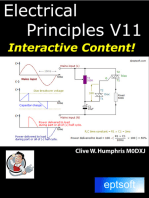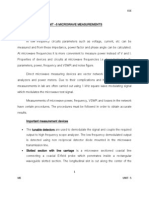Offset-Free Bidirectional Current Source For Impedance Measurement
Offset-Free Bidirectional Current Source For Impedance Measurement
Uploaded by
Herman ToothrotCopyright:
Available Formats
Offset-Free Bidirectional Current Source For Impedance Measurement
Offset-Free Bidirectional Current Source For Impedance Measurement
Uploaded by
Herman ToothrotOriginal Title
Copyright
Available Formats
Share this document
Did you find this document useful?
Is this content inappropriate?
Copyright:
Available Formats
Offset-Free Bidirectional Current Source For Impedance Measurement
Offset-Free Bidirectional Current Source For Impedance Measurement
Uploaded by
Herman ToothrotCopyright:
Available Formats
Offset-free bidirectional current source for impedance
measurement
Uwe Pliquett, Markus Schnfeldt, Andreas Barthel, Dieter Frense, Thomas
Nacke
Institut fr Bioprozess- und Analysenmesstechnik e.V., Rosenhof
D-37308 Heilbad Heiligenstadt, Germany
uwe.pliquett@iba-heiligenstadt.de
Abstract. In order to minimize the influence of electrode polarization and noise in impedance measurements,
especially in the low frequency region, current injection shows several advantages compared to voltage
application. Although the existence of a great variety of current sources, they meet our requirements only
partially. We developed a voltage controlled current source for active front ends for a wide range of impedances,
from up to T. A broad bandwidth from dc to 100 MHz was ensured by minimizing the parasitic
capacitances. The current source outputs a symmetric signal without dc-offset. This is accomplished by a
differential driver where the non-inverting branch was used for creating a current conveyor while the inverting
branch host the feedback for offset control. We focused especially on the stability of the current source for usage
with small metal electrodes in aqueous solutions.
1. Introduction
Bioimpedance measurement is a simple and innocuous method for electrical characterization of
biological matter [1;2]. Especially in the low frequency region from 100 Hz up to 10 MHz the
behavior of the lipid membranes in cell structures dominate the impedance spectrum [3]. The
impedance measurement in this frequency range employs either a voltage excitation of the material
under test (MUT) and monitors the current through the material or vice versa. Other methods, like
bridge calibration, are not considered here.
The theoretical background for electrodes with geometrical dimensions on the order of centimeters
is teaching book material. Both, potentiostatic or galvanostatic excitation is well established and a
great variety of devices for impedance measurement exist. However, if the same theory and the same
devices are used in conjunction with microelectrodes, a departure from the expected results is often
observed. The reason is the non-ideal behavior of the front end together with the usually neglected
electrochemistry at the electrodes, even below the decomposition voltage. Often, any change in current
density at the electrodes is not taken into account and parasitic elements at the input of the voltage
monitor are neglected as well. Here we show how to circumvent these problems at least partially.
Besides using a voltage monitor with extremely high input impedance, a symmetrical current
source for dc-offset free excitation can compensate asymmetric influences of the electrochemical
reactions at the electrodes.
2. Electrode polarization
In numerous applications the MUT is connected to the electronics via galvanically coupled electrodes.
The most employed electrode materials are metals like iron (stainless steel), titanium, gold or
platinum.
A double layer develops at the electrode-electrolyte interface [2]. At low frequencies, the
impedance of this double layer has a similar magnitude as the impedance of the biological object. Any
measurement done with two electrodes will result in the real impedance of the MUT plus the
impedance of the electrodes. In order to overcome this, the four electrode interface, where an outer
pair of electrodes is used for the application of the excitation signal (applicator electrodes) and the
inner electrodes are used for monitoring the voltage dropping across the MUT (monitor electrodes)
was introduced. In such an arrangement, any voltage dropping at the impedance of the applicator
electrodes influences the measurement result only negligibly [4]. If the potential difference between
both single monitor electrodes and the bulk electrolyte is equal, the measured voltage between the
inner electrodes will truly be the voltage drop between the inner electrodes.
In this sense, it is quite unimportant whether a potentiostatic or galvanostatic excitation is used. As
a matter of fact, even if neither, current nor voltage is controlled, impedance measurement would
theoretically work just by measuring voltage and current.
When microelectrodes are used, the outer electrodes can influence the inner electrode by very close
location. Moreover, due to the high curvature of such electrodes, local high field strength can
overcome the limits for linearity resulting in harmonic distortion, even at low voltage. This means,
especially for miniaturized electrodes with sharp geometry any change in the current density at the
outer electrodes will influence the measured signal at the inner electrodes. Using a galvanostatic
approach controls the current density and therefore prevents unpredictable interaction between
applicator and monitor electrodes.
3. Current source for excitation
It is generally accepted that excitation signals for bio-impedance measurements should be dc-offset
free in order to minimize electrochemical effects at the material [5]. Offset free means that the time
average of the signal is zero. Although the current through the current carrying electrodes is always
complementary, even if one electrode is connected to ground, the voltage at the monitor electrodes
may be very different (Fig.1a). This implies of course no shunting pathways to ground or any other
potential, i.e. the MUT is electrically fully insulated from the environment. Although this sounds
simple and clear, researchers often forget about hidden grounding or electrical connections when
doing impedance measurements outside the laboratory.
Rel
M
U
T
R
e
l
R
e
l
Rel
+
-
UHI
U
LO
U
appl
parasitic
elements
t
-1 -0.8 -0.6 -0.4 -0.2 0 0.2 0.4 0.6 0.8 1
-500
-400
-300
-200
-100
0
100
200
300
400
500
U / V
I
/
A
Fig.1a. Input signal at the monitor electrodes due to the excitation by an offset free but not
symmetrical signal. Although the input impedance of the difference amplifier is ideally infinite,
parasitic elements yield an asymmetric current at the monitor electrodes, which disturbs dramatically
the compensation of the electrode polarization for a tetra-polar interface. (b) Voltagram of a gold
electrode of 1 cm in contract with 100 mM KCl
The potential drop between an electrode and the bulk electrolyte depends on the current density. Using
cyclic voltammetry, reveals a small range, usually below 100 mV, where the electrode behaves
linearly (Fig.1b). Exceeding this range, yields nonlinear behaviour of the electrode which generates
harmonic distortion [6].
The influence of the double layer at the monitor electrodes can be partially compensated using a
high symmetry of all signals with respect to ground. This yields the same electrode polarization at
a b
both monitor electrodes which is compensated by using the difference of both signals for further
processing. This approach implies the usage of a symmetric excitation source, where the potential at
the applicator electrodes is complementary with respect to ground. Moreover, a controlled current
rather than the voltage yields lower distortion from the applicator electrodes.
4. Symmetric high bandwidth current source
The symmetry of the applicator electrodes with respect to ground ensures the same time averaged
speed and extent of electrochemical reactions at the voltage monitoring electrodes in tetrapolar
applications.
The newly developed current source is a successor of the well known Howland-Circuit which can
be regarded as current conveyor. Other than the general Howland-Circuit which is a high side driver
with respect to ground, the new approach uses the both outputs of a symmetric line driver (OPA1) in
order to ensure a symmetric output (Fig.2). Only the non-inverting output is used for the feedback
from the sampling resistor R
s
. After buffering (OPA2), which ensures essentially no current is injected
into the feedback loop, the signal is summarized with the input signal and feed into the non-inverting
input. In order to compensate the voltage drop at the sampling resistor, a second resistor of the same
size is added to the inverting output. The current though the output loop is: I = U
in
/ R
s
. The high
impedance instrumentation amplifier (OPA3) is used as current monitor.
Fig. 2. Simplified schematic of the symmetric and offset free current source
A second feedback is used for offset compensation. Therefore the inverted output is buffered (OPA4)
and integrated (OPA5/C1/R5) in order to monitor the actual offset. This signal is fed into the inverting
input of OPA1. The loop gain is adjusted using R3/R4.
10
2
10
4
10
6
10
8
10
2
10
4
10
6
10
8
-5
0
5
f / Hz
a
Z
L
/
d
B
10
2
10
4
10
6
10
8
10
2
10
4
10
6
10
8
-5
0
5
f / Hz
b
Z
L
/
d
B
Fig.3. Voltage across the load resistor in dB with respect to the input voltage U
in
. The sample resistor
was (a) 1 M and (b) 1 G.
Measurements
Initial tests for symmetry and stability were done on SMD-resistors using an oscilloscope together
with a square wave generator (1 kHz, 0.2 V). The stability of the source was proven over a wide range
of sample and load resistors (10 10 G).
The frequency response of the current source was further tested in a range from 100 Hz up to 100
MHz. A HP4194A network analyzer applied an U
in
of 0.5 V and measured the voltage across the
load resistor. In Fig.3 is the logarithmic ratio of the voltage across the load resistor and the input
voltage in dB shown.
For test with real electrode systems we used an electrode as shown in Fig.4a. The current was
injected at the outer electrodes and the voltage at the inner electrodes was monitored using an
instrumentation amplifier like for monitoring the current. Different ionic solutions, from distilled
water up to high ionic strength were used for testing. Fig.4b shows an example for distilled water. The
voltage trace shows a time constant due to the high permittivity of the water.
Fig.4a. Example of an electrode system as it is used in flow chambers. (b). Current and voltage trace
for a square wave applied to U
in
of the current source. The chamber filled with distilled water. A 1 k
sample resistor was used.
5. Conclusion
Impedance measurement using galvanically coupled electrodes relies on the transduction of the
excitation signal from the electrode to the material under test. Artifacts due to the electrochemistry at
the electrodes can be partially compensated using current excitation rather than voltage controlled
signals. Monitoring the voltage across an additional pair of electrodes can greatly enhance the
performance at low frequencies, but is influenced by parasitic elements in the setup, especially if one
applicator electrode is grounded. The current source presented here will circumvent this problem due
to its symmetric output. Moreover, the dc-offset free signal prevents electrochemical reactions at the
applicator electrodes.
References
[1] K.R.Foster and H.P.Schwan, Dielectric properties of tissues and biological materials : A critical
review. CRC Crit.Rev.Biomed.Eng. 17 (1989) 25-104.
[2] S.Grimnes and O.G.Martinsen, (2000) Bioimpedance and Bioelectricity Basics, Academic
Press.
[3] H.P.Schwan, (1957) Electrical Properties of Tissue and Cell Suspensions, in: J.H.Lawrence and
C.A.Tobias (Eds.) Academic Press, New York, 1957 p. 147
[4] H.P.Schwan, (1963) Determination of biological impedances, in: W.L.Nastuk (Ed.) Physical
Techniques in Biological Research, Academic Press, New York, 1963 pp. 323-407
[5] R.Bragos, J.Rosell, and P.Riu, A wide-band AC-coupled current source for electrical impedance
tomography. Physiol.Meas.1994) 91-100.
[6] M.Moussavi, H.P.Schwan, and H.H.Sun, Harmonic distortion caused by electrode polarisation.
Med.Biol.Eng.Comput. 32 (1994) 121-125.
You might also like
- Jonas Salk - The Survival of The Wisest (1973, Harper & Row) - Libgen - LiDocument152 pagesJonas Salk - The Survival of The Wisest (1973, Harper & Row) - Libgen - LiHerman Toothrot100% (7)
- HSE 03 Kitchen Inspection ChecklistDocument3 pagesHSE 03 Kitchen Inspection ChecklistApirinmu100% (10)
- Yamaha - Service Manual - F300aDocument572 pagesYamaha - Service Manual - F300aJorge Lopes100% (1)
- Authority To Sell and Formal Client RegistrationDocument2 pagesAuthority To Sell and Formal Client RegistrationEuneun Bustamante100% (1)
- Sualaptop365.edu - VN - Lenovo ThinkPad S5-S540 VIUS6 LA-A171P r10Document46 pagesSualaptop365.edu - VN - Lenovo ThinkPad S5-S540 VIUS6 LA-A171P r10Herman Toothrot100% (1)
- Nouveau Document Microsoft WordDocument7 pagesNouveau Document Microsoft WordAbdelkarim MessaoudiNo ratings yet
- Universal Currnet SensorDocument15 pagesUniversal Currnet SensorJohnny Rider100% (1)
- Switching e Handbk NeuDocument33 pagesSwitching e Handbk NeuArash MazandaraniNo ratings yet
- Tel20104 Lab 6 & 7 PDFDocument19 pagesTel20104 Lab 6 & 7 PDFNur HidayahNo ratings yet
- Isolation Transformer Downstream of A UPS Causes Catastrophic DamageDocument15 pagesIsolation Transformer Downstream of A UPS Causes Catastrophic DamagePudeti RaghusreenivasNo ratings yet
- Module CE163 Laboratory Report 3Document10 pagesModule CE163 Laboratory Report 3Vlad SimizeanuNo ratings yet
- Voltage DividerDocument11 pagesVoltage DividerLorshiel Anne TusingNo ratings yet
- Analog Electronic WattmetrDocument2 pagesAnalog Electronic WattmetrKaran AnejaNo ratings yet
- EEE Lab Report 2.2Document42 pagesEEE Lab Report 2.2leon saifullahNo ratings yet
- FE-Modelling of Induction Tool Responses: F Iii: GDocument4 pagesFE-Modelling of Induction Tool Responses: F Iii: GtomhowNo ratings yet
- Automatic Phase ChangerDocument55 pagesAutomatic Phase ChangerGanpati Kucheria75% (4)
- Reciprocal Operation of Ultrasonic Transducers Experimental ResultsDocument4 pagesReciprocal Operation of Ultrasonic Transducers Experimental Resultsishi888No ratings yet
- Exercise 3.2Document2 pagesExercise 3.2Utibe IkpembeNo ratings yet
- Potentiostat FundamentalsDocument5 pagesPotentiostat FundamentalsYousuf RazaNo ratings yet
- The Universal Current SensorDocument4 pagesThe Universal Current SensormsivakumarvarmaNo ratings yet
- Group3 ICE3205 Voltammetry SummaryDocument13 pagesGroup3 ICE3205 Voltammetry SummarySamantha Nicole AtienzaNo ratings yet
- Electrical Type Flow MetersDocument22 pagesElectrical Type Flow MetersAnuNarayan R0% (1)
- current electricity_com_fileDocument23 pagescurrent electricity_com_filelucifermorningstar666990No ratings yet
- Multiple Continuity TesterDocument18 pagesMultiple Continuity TesterbnurkholisNo ratings yet
- IEEE - 2006 - Degen and Jackel - A Pseudodiffer Amp For Bioelectric Events With DC Offset Compensation Using Two Wired Amplifying ElectrodesDocument11 pagesIEEE - 2006 - Degen and Jackel - A Pseudodiffer Amp For Bioelectric Events With DC Offset Compensation Using Two Wired Amplifying ElectrodesshreypathakNo ratings yet
- Term Paper Topic: Magnetic CouplingDocument13 pagesTerm Paper Topic: Magnetic Couplingshailesh singhNo ratings yet
- ContentDocument31 pagesContentSiva ForeviewNo ratings yet
- Single Electron Based Binary Multipliers With Overflow DetectionDocument13 pagesSingle Electron Based Binary Multipliers With Overflow Detectionprabhjot singh1No ratings yet
- Chapter 2 DC Circuit TheoryDocument37 pagesChapter 2 DC Circuit TheoryTynoh MusukuNo ratings yet
- Thong So ESPDocument6 pagesThong So ESPduongthetinhqbNo ratings yet
- Biomedicak Instrumentation LabDocument56 pagesBiomedicak Instrumentation LabMD. ASHIQUR RAHMAN 1602111No ratings yet
- AnshuDocument26 pagesAnshuAnubha ChaudharyNo ratings yet
- All ExperimentsDocument157 pagesAll Experiments9b15rudra.keshNo ratings yet
- Fundamentals of Floating Measurements and Isolated Input Oscilloscopes - Tektronix - 3AW - 19134 - 2 - MR - LetterDocument8 pagesFundamentals of Floating Measurements and Isolated Input Oscilloscopes - Tektronix - 3AW - 19134 - 2 - MR - LetterluroguitaNo ratings yet
- I DQ DT: Topic 1: Basic Concepts 1.0 CurrentDocument11 pagesI DQ DT: Topic 1: Basic Concepts 1.0 Currentkumares_nfbmNo ratings yet
- 2006 - Induscon 2006 - EVALUATION OF A PRE-PROTOTYPE OPTICAL VOLTAGE SENSOR BASED ON THE ELECTRO OPTIC EFFECT IN LITHIUM NIOBATE CRYSTALDocument7 pages2006 - Induscon 2006 - EVALUATION OF A PRE-PROTOTYPE OPTICAL VOLTAGE SENSOR BASED ON THE ELECTRO OPTIC EFFECT IN LITHIUM NIOBATE CRYSTALClaudioCaetanoNo ratings yet
- Ece 3323 Experiment 1Document11 pagesEce 3323 Experiment 1TANQUERO_WW20% (2)
- Recording Sysytem: Sources of Noise in Low Level Recording CircuitsDocument5 pagesRecording Sysytem: Sources of Noise in Low Level Recording CircuitsPulkit SharmaNo ratings yet
- Detrimental Effects of Capacitors in Distribution Networks in The Presence of Harmonic PollutionDocument5 pagesDetrimental Effects of Capacitors in Distribution Networks in The Presence of Harmonic PollutionLuis CifuentesNo ratings yet
- Control Electrical Appliances Using PC Project ReportDocument47 pagesControl Electrical Appliances Using PC Project ReportUtkarsh AgrawalNo ratings yet
- Chapter 2: DC Circuit TheoryDocument37 pagesChapter 2: DC Circuit TheoryTaonga Nhambi100% (1)
- Electronics Engineering Notes Unit 1st YearDocument11 pagesElectronics Engineering Notes Unit 1st Yearmahvs.1311No ratings yet
- Wireless Power Transfer Literature Review by Naters BishDocument15 pagesWireless Power Transfer Literature Review by Naters BishNaters BishNo ratings yet
- Inductive ReactiveDocument5 pagesInductive ReactivetahaNo ratings yet
- Voltage Load Resistance Dual Current Source: Added/subtracted in Series Must Be Same in ParallelDocument8 pagesVoltage Load Resistance Dual Current Source: Added/subtracted in Series Must Be Same in ParallelDuck520No ratings yet
- Modeling of A Discharging Cavity in A Dielectric Material ExposedDocument6 pagesModeling of A Discharging Cavity in A Dielectric Material Exposedreply2amit1986No ratings yet
- VSWR Measurement, Microwave Engineering, Microwave Measurement, Power Meter, Measurement of Standing Wave PatternsDocument16 pagesVSWR Measurement, Microwave Engineering, Microwave Measurement, Power Meter, Measurement of Standing Wave Patternsvlsijp100% (1)
- Analog and Digital Electronics (Subject Code: 17CS32) Lecturer NotesDocument59 pagesAnalog and Digital Electronics (Subject Code: 17CS32) Lecturer NotesKarthik v BhatNo ratings yet
- Smart Home Security System Usingandroid New DocumntDocument57 pagesSmart Home Security System Usingandroid New DocumntRohitdhanne Dhanne100% (3)
- Slide 4Document59 pagesSlide 4Mr RobotNo ratings yet
- Building Services Book 2Document237 pagesBuilding Services Book 2Africana RoyalNo ratings yet
- 04_High Voltage Substation Earth Grid Impedance Testing_OMICRONDocument6 pages04_High Voltage Substation Earth Grid Impedance Testing_OMICRONalmir.mahmutovic01No ratings yet
- An Active, Microfabricated, Scalp Electrode Array For EEG RecordingDocument6 pagesAn Active, Microfabricated, Scalp Electrode Array For EEG RecordingChristopher RoblesNo ratings yet
- Impact of Variable Switching Frequency Over Power Loss On Converter TopologiesDocument6 pagesImpact of Variable Switching Frequency Over Power Loss On Converter TopologiesskrtamilNo ratings yet
- 19el02 EnaDocument12 pages19el02 EnaHooram AliNo ratings yet
- Lenovo Ideapad Z580 Quanta Lz3a (DALZ3AMB8E0) Rev 1A SchematicsDocument44 pagesLenovo Ideapad Z580 Quanta Lz3a (DALZ3AMB8E0) Rev 1A SchematicsHerman ToothrotNo ratings yet
- Gateway NV52 MS2274 Wistron SJV50-PU Rev-1Document59 pagesGateway NV52 MS2274 Wistron SJV50-PU Rev-1Herman ToothrotNo ratings yet
- HP Pavilion 17t-Ab Series Quanta G37A - G37B R1aDocument51 pagesHP Pavilion 17t-Ab Series Quanta G37A - G37B R1aHerman ToothrotNo ratings yet
- The Global Rebalancing: What Is It? Why Is It Happening?Document1 pageThe Global Rebalancing: What Is It? Why Is It Happening?Herman ToothrotNo ratings yet
- Sualaptop365.edu - VN - Quanta LZ9A SKB - DIS - 0415 PDFDocument47 pagesSualaptop365.edu - VN - Quanta LZ9A SKB - DIS - 0415 PDFHerman ToothrotNo ratings yet
- Abstract Hnatiuc Mycobacteria v2 PDFDocument1 pageAbstract Hnatiuc Mycobacteria v2 PDFHerman ToothrotNo ratings yet
- Pawgc - D La-6755 - 57Document51 pagesPawgc - D La-6755 - 57fdsaq12No ratings yet
- Iet LCR Primer 1st EditionDocument85 pagesIet LCR Primer 1st EditionHerman ToothrotNo ratings yet
- Esr Meter KakopaDocument10 pagesEsr Meter KakopaHerman ToothrotNo ratings yet
- Acer Aspire 7336 7336g 7336gz 7336z 7736 7736g 7736gz 7736z jv71-mv (09242-1 4fx01)Document60 pagesAcer Aspire 7336 7336g 7336gz 7336z 7736 7736g 7736gz 7736z jv71-mv (09242-1 4fx01)smooky1980No ratings yet
- Radar MTI-MTD Implemetation & Performance (JNL Article) (2000) WWDocument5 pagesRadar MTI-MTD Implemetation & Performance (JNL Article) (2000) WWHerman ToothrotNo ratings yet
- Acer TravelMate 5730 - WISTRON Homa 3g - SCDocument56 pagesAcer TravelMate 5730 - WISTRON Homa 3g - SCDiego R. NoalNo ratings yet
- Acer I5 47501306462469980Document67 pagesAcer I5 47501306462469980fdsaq12No ratings yet
- Design of Concrete Bridges: Praveen NagarajanDocument18 pagesDesign of Concrete Bridges: Praveen NagarajanSSNo ratings yet
- Course Description 100 LEVEL EPM 111: Principles of Environmental Planning and ManagementDocument8 pagesCourse Description 100 LEVEL EPM 111: Principles of Environmental Planning and ManagementAlvinTiteNo ratings yet
- Business Plan - FinalDocument10 pagesBusiness Plan - FinalMaurice Ashley FanogaNo ratings yet
- 2022 Updated SLCC Sing Safely Guidelines - 1.07.22 - FINAL - 20220108175728Document3 pages2022 Updated SLCC Sing Safely Guidelines - 1.07.22 - FINAL - 20220108175728Adrielle AruyaNo ratings yet
- RS Handbook Fall Final 2022upDocument27 pagesRS Handbook Fall Final 2022upIbrahim AlifNo ratings yet
- Nama Kumpulan & TajukDocument10 pagesNama Kumpulan & Tajukfazilarazali80No ratings yet
- Inventv 2022Document21 pagesInventv 2022Din DinNo ratings yet
- TPM SLB 9635 TT 1.2Document78 pagesTPM SLB 9635 TT 1.2Phương Vũ100% (1)
- Luminaries InstructionsDocument2 pagesLuminaries InstructionslupepatchNo ratings yet
- E-Versuri Ro - Rihana - UmbrelaDocument2 pagesE-Versuri Ro - Rihana - Umbrelaanon-821253100% (1)
- Lesson Plan Unit 5F - FRIENDS GLOBAL - GRADE 11Document11 pagesLesson Plan Unit 5F - FRIENDS GLOBAL - GRADE 11LinhLyNo ratings yet
- Hachalu Hundessa Campus IOT Department of Information TechnologyDocument10 pagesHachalu Hundessa Campus IOT Department of Information Technologymikeyas meseretNo ratings yet
- Power Plant Controller-Putting The Power Back Into The Hands of The DeveloperDocument6 pagesPower Plant Controller-Putting The Power Back Into The Hands of The DeveloperSgurr EnergyNo ratings yet
- Homeostasis FSC Biology Notes Part 2 Chapter 15Document18 pagesHomeostasis FSC Biology Notes Part 2 Chapter 15yaseen shah100% (1)
- Kubernates-Part1Document28 pagesKubernates-Part1Sreenivas KalahastiNo ratings yet
- Design of Load Bearing StructuresDocument12 pagesDesign of Load Bearing StructuresKarthikeya SarmaNo ratings yet
- WomeninministryDocument34 pagesWomeninministryzaneleNo ratings yet
- 9781315858715Document566 pages9781315858715Priyanka Krishna100% (1)
- Omni and Multi ChannelDocument10 pagesOmni and Multi ChannelburanNo ratings yet
- Anritsu S362EDocument112 pagesAnritsu S362Epinakin22No ratings yet
- Chem Taster Sheet 2Document1 pageChem Taster Sheet 2Haikalsalihin100coolNo ratings yet
- Accounting FinalDocument208 pagesAccounting Finalabdul abdulNo ratings yet
- Life in Medieval Towns TextDocument10 pagesLife in Medieval Towns Textapi-233464494100% (1)
- Revenue IntegrityDocument30 pagesRevenue Integritypallavi@igt100% (2)
- Michelle Estenson Letter of RecDocument2 pagesMichelle Estenson Letter of Recapi-513408923No ratings yet
- PDF List of HR Persons Companies Ascending OrderDocument13 pagesPDF List of HR Persons Companies Ascending OrderRainwaterNo ratings yet
- Sailing Home Sheet UpdatedDocument6 pagesSailing Home Sheet UpdatedRosina RobertNo ratings yet








































































































